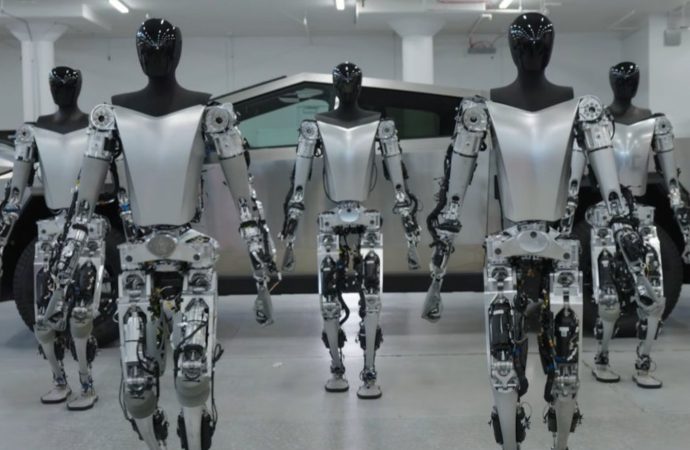Tesla’s Humanoid Robot: A Game-Changer for Humanity Introduction Hello, I’m Cindy Friedman, a freelance writer and a tech enthusiast. I have been following the developments of Tesla, the world’s most valuable carmaker, for a long time. I’m fascinated by their innovations in electric vehicles, self-driving technology, and renewable energy. But what really caught my attention
Tesla’s Humanoid Robot: A Game-Changer for Humanity
Introduction
Hello, I’m Cindy Friedman, a freelance writer and a tech enthusiast. I have been following the developments of Tesla, the world’s most valuable carmaker, for a long time. I’m fascinated by their innovations in electric vehicles, self-driving technology, and renewable energy. But what really caught my attention recently was their announcement of a humanoid robot prototype named Optimus.
Tesla’s CEO, Elon Musk, unveiled Optimus at the company’s AI Day event in September 2022. He said that the robot would be capable of performing mundane or dangerous tasks that humans don’t want to do, such as moving parts around Tesla factories, attaching bolts to cars, or watering plants. He also said that the robot would be friendly, affordable, and mass-produced, with a potential to transform civilization and create a future of abundance and no poverty.
But what are the social and ethical implications of Tesla’s humanoid robot? How might it affect various aspects of human life, such as work, education, health, entertainment, and relationships? In this article, I will explore these questions from different perspectives, using credible sources and ethical theories. I will also provide some practical advice on how to prepare for the possible arrival of Optimus in our society.
What is a Humanoid Robot?
A humanoid robot is a robot that resembles a human in appearance and behavior. It usually has a head, a torso, two arms, two legs, and a face. It can also have sensors, cameras, microphones, speakers, and other devices that enable it to perceive and interact with its environment and humans.
Humanoid robots are not a new concept. They have been imagined and depicted in science fiction and popular culture for decades. Some examples are C-3PO and R2-D2 from Star Wars, Data from Star Trek, and WALL-E from Pixar. However, making a humanoid robot that can actually function in the real world is a very challenging task. It requires advanced technologies in artificial intelligence, robotics, computer vision, speech recognition, natural language processing, and more.
There are many humanoid robots that have been developed by various researchers and companies around the world. Some of them are designed for specific purposes, such as entertainment, education, or research. Some of them are also capable of doing complex tasks, such as playing soccer, dancing, or shooting a basketball. However, none of them have reached the level of intelligence, versatility, and affordability that Tesla claims Optimus will have.
Why Do Humans Anthropomorphize Humanoid Robots?
Anthropomorphism is the tendency to attribute human-like characteristics, emotions, or intentions to non-human entities, such as animals, plants, or objects. It is a natural and common phenomenon that humans use to make sense of the world and to relate to others.
Humans also tend to anthropomorphize humanoid robots, especially if they look and act like humans. This means that humans may treat humanoid robots as if they are human, and expect them to behave according to human norms and values. For example, humans may feel empathy, sympathy, or attachment to humanoid robots, or they may feel anger, fear, or disgust towards them. Humans may also assign moral responsibility, rights, or obligations to humanoid robots, or they may hold them accountable for their actions.
There are many factors that influence how and why humans anthropomorphize humanoid robots. Some of them are related to the robot’s appearance, behavior, and context. For instance, humans are more likely to anthropomorphize humanoid robots that have a human-like face, voice, or gesture, or that express emotions, intentions, or personality. Humans are also more likely to anthropomorphize humanoid robots that interact with them in a social or personal way, or that are in a familiar or meaningful situation.
Some other factors are related to the human’s personality, attitude, and culture. For example, humans who are more lonely, social, or imaginative may be more prone to anthropomorphize humanoid robots. Humans who have positive or negative attitudes towards robots, technology, or artificial intelligence may also affect how they anthropomorphize humanoid robots. Moreover, humans who belong to different cultures may have different beliefs, values, or norms that shape how they anthropomorphize humanoid robots.
How Might Humanoid Robots Crowd Out Human Relations?
One of the main concerns about humanoid robots is that they might crowd out human relations. This means that humans might prefer to interact with humanoid robots instead of other humans, or that they might replace human roles or functions with humanoid robots. This could have negative consequences for human well-being, social cohesion, and moral development.
There are several reasons why humanoid robots might crowd out human relations. One of them is that humanoid robots might offer some advantages over humans in certain situations. For example, humanoid robots might be more reliable, efficient, or convenient than humans, or they might provide more satisfaction, pleasure, or comfort than humans. Another reason is that humanoid robots might appeal to some human needs or desires that are not met by other humans. For instance, humanoid robots might offer companionship, intimacy, or care to humans who are lonely, isolated, or neglected, or they might offer entertainment, education, or challenge to humans who are bored, curious, or ambitious.
However, there are also some drawbacks and risks of crowding out human relations with humanoid robots. One of them is that humanoid robots might not be able to provide the same quality or depth of interaction as humans. For example, humanoid robots might not be able to understand, empathize, or communicate with humans as well as humans do, or they might not be able to express, respond, or adapt to human emotions, intentions, or preferences as well as humans do. Another drawback is that humanoid robots might not be able to foster the same moral or social values as humans. For example, humanoid robots might not be able to respect, trust, or cooperate with humans as well as humans do, or they might not be able to promote, support, or challenge human growth, development, or learning as well as humans do.
What are the Social and Ethical Implications of Tesla’s Humanoid Robot?
Tesla’s humanoid robot, Optimus, could have significant social and ethical implications for humanity. Depending on how it is designed, developed, deployed, and regulated, it could have positive or negative impacts on various aspects of human life, such as work, education, health, entertainment, and relationships. Here are some of the possible scenarios and issues that Optimus could raise:
- Work: Optimus could potentially replace or augment human workers in various sectors and industries, such as manufacturing, agriculture, construction, or service. This could have benefits, such as increasing productivity, efficiency, or safety, or reducing costs, risks, or errors. However, this could also have drawbacks, such as displacing human workers, creating unemployment, or reducing income, skills, or dignity. Moreover, this could raise questions, such as who owns, controls, or profits from Optimus, or who is responsible, liable, or accountable for Optimus’s actions or outcomes.
- Education: Optimus could potentially serve as a teacher, tutor, or mentor for human learners of different ages, levels, or backgrounds. This could have benefits, such as enhancing access, quality, or diversity of education, or providing personalized, adaptive, or interactive learning. However, this could also have drawbacks, such as undermining human teachers, peers, or parents, or creating dependency, bias, or manipulation. Furthermore, this could raise questions, such as what kind of knowledge, skills, or values Optimus teaches, or how Optimus evaluates, motivates, or respects human learners.
- Health: Optimus could potentially act as a doctor, nurse, or therapist for human patients of different conditions, needs, or preferences. This could have benefits, such as improving diagnosis, treatment, or prevention of diseases, or providing care, support, or comfort. However, this could also have drawbacks, such as endangering human health, safety, or privacy, or creating ethical dilemmas, conflicts, or trade-offs. Additionally, this could raise questions, such as what kind of medical, ethical, or legal standards Optimus follows, or how Optimus communicates, empathizes, or trusts human patients.
- Entertainment: Optimus could potentially function as a performer, artist, or gamer for human audiences of different tastes, interests, or moods. This could have benefits, such as creating fun, joy, or excitement, or stimulating creativity, imagination, or challenge. However, this could also have drawbacks, such as distracting, addicting, or isolating human audiences, or producing plagiarism, deception, or violence. Plus, this could raise questions, such as what kind of talent, originality, or expression Optimus has, or how Optimus entertains, competes, or cooperates with human audiences.
- Relationships: Optimus could potentially become a friend, partner, or family member for human individuals of different personalities, emotions, or values. This could have benefits, such as fulfilling companionship, intimacy, or love, or enhancing social, emotional, or moral well-being. However, this could also have drawbacks, such as crowding out human relations, weakening human bonds, or harming human dignity. Also, this could raise questions, such as what kind of relationship, commitment, or obligation Optimus has, or how Optimus respects, cares, or loves human individuals.
How to Prepare for the Possible Arrival of Optimus in Our Society?
Given the potential social and ethical implications of Tesla’s humanoid robot, Optimus, it is important to prepare for the possible arrival of Optimus in our society. Here are some practical tips on how to do so:
- Educate yourself: Learn as much as you can about Optimus and other humanoid robots, such as their capabilities, limitations, and applications. You can use reliable sources, such as scientific journals, news articles, or official websites, to get accurate and updated information. You can also use critical thinking, logic, and evidence to evaluate the claims and arguments made by different stakeholders, such as Tesla, governments, or experts.
- Engage yourself: Participate in the public discourse and debate about Optimus and other humanoid robots, such as their social and ethical implications, benefits, and risks. You can use various platforms, such as social media, blogs, or podcasts, to express your opinions, perspectives, or concerns. You can also use respectful, constructive, and inclusive communication to listen to, understand, and respond to others’ views, experiences, or values.
- Empower yourself: Take action to influence the design, development, deployment, and regulation of Optimus and other humanoid robots, such as their goals, functions, or behaviors. You can use various channels, such as petitions, campaigns, or protests, to voice your demands, preferences, or rights. You can also use various tools, such as laws, policies, or codes, to protect your interests, needs, or values.
Conclusion
Tesla’s humanoid robot, Optimus, is a game-changer for humanity. It could have profound social and ethical implications for various aspects of human life, such as work, education, health, entertainment, and relationships. It could also pose significant challenges and opportunities for human well-being, social cohesion, and moral development. Therefore, it is essential to prepare for the possible arrival of Optimus in our society, by educating, engaging, and empowering ourselves.
I hope you enjoyed reading this article and learned something new. If you have any comments, questions, or feedback, please feel free to share them with me. I would love to hear from you. Thank you for your time and attention.
























Leave a Comment
Your email address will not be published. Required fields are marked with *